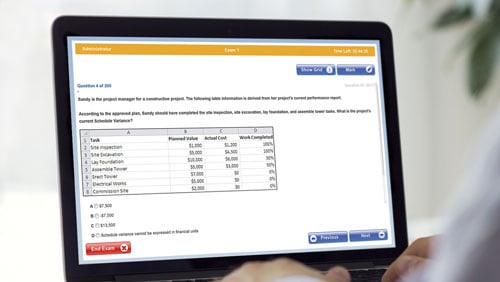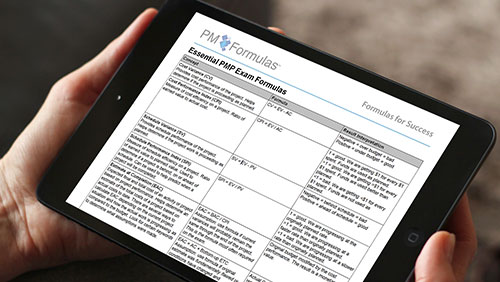Do I Have to Read the Agile Practice Guide for the PMP® Exam?
 A Guide to the Project Management Body of Knowledge (PMBOK® Guide) - Sixth Edition is significantly different from the prior Fifth Edition in that it is published and bundled together with the Agile Practice Guide. The inclusion of this new practice guide has created some confusion around what a student should study to prepare for the Project Management Professional (PMP)® exam.
A Guide to the Project Management Body of Knowledge (PMBOK® Guide) - Sixth Edition is significantly different from the prior Fifth Edition in that it is published and bundled together with the Agile Practice Guide. The inclusion of this new practice guide has created some confusion around what a student should study to prepare for the Project Management Professional (PMP)® exam.
What is the Agile Practice Guide?
First of all, what is the Agile Practice Guide? Much like the PMBOK® Guide, the Agile Practice Guide was developed to provide project management-related guidance. However, whereas the PMBOK® Guide provides broad guidance on effective project management, the content of the Agile Practice Guide focuses on agile practices, which apply to those adopting an agile approach to the planning and execution of projects. The Agile Practice Guide was developed through a collaboration between the Project Management Institute (PMI)® and the Agile Alliance® in order to connect and relate waterfall and agile approaches.
Since 2012, when PMI® first introduced the PMI Agile Certified Practitioner (PMI-ACP)® exam, Agile has continued to grow in usage and acceptance. PMI even recognizes the PMI-ACP® as its fastest-growing certification. Agile encompasses several different methods such as Kanban, Lean, Scrum, extreme programming (XP), and test-driven development, which means the use of agile approaches can span many industries. The PMI-ACP Exam tests for in-depth knowledge of agile practices, tools and techniques.
What does PMI say about Agile questions on the PMP exam?
Although Agile is growing, you should not expect to see too many Agile questions on the PMP exam at this time. Reading the Agile Practice Guide once should be enough to get you through the agile questions that may appear on the PMP® exam. At this point, there is no reason to take a deep dive into it to pass the PMP exam. Simona Fallavollita, Product Manager for PMI, had the following to say when asked if those who are preparing for the PMP exam also need to read the Agile Practice Guide:
“The Agile Practice Guide offers a more comprehensive perspective on agile applications and is a useful resource for gaining a greater understanding of this approach to project management. In-depth knowledge of agile practices is not required for the PMP®. Although there could be some agile questions on the PMP exam, as we know the practice of agile methods is growing in prominence and project managers need to be equipped to choose the most appropriate approach for their projects. However, any agile-related questions would still need to fit within the context of the current PMP exam content outline. That being the case, people should not expect to see an in-depth assessment of agile topics on the PMP exam.”
Additionally, PMI also has this FAQ on their website: https://www.pmi.org/pmbok-guide-standards/faq
The main reason why students are confused about whether or not the practice guide must be studied for exam prep is this: Many are under a false impression that the PMP exam is solely based on the PMBOK® Guide. And so, when PMI chose to bundle the Agile Practice Guide with the PMBOK® Guide - Sixth Edition, it created the incorrect impression that agile is now part of the exam. However, PMI produces many global standards and practice guides related to various aspects of project management. If one of these other guides such as the Practice Standard for Project Configuration Management were bundled with the PMBOK® Guide, that wouldn’t necessarily mean that in-depth questions on project configuration management would suddenly be on the PMP exam. Instead, the PMP Exam – as you will see later in this article – is based on the PMP Examination Content Outline.
What Agile questions should I expect on the PMP Exam?
Here are two sample PMP exam question related to agile taken from The PM Exam Simulator:
Sample Question #1
You are leading a project to develop a new web application. Together with your project team you reprioritize the product backlog, determine velocity for the past iterations, and adapt your work plans accordingly. Additionally, you facilitate retrospectives every two weeks. Which of the following processes describes the work you are performing?
A. Monitor Risks
B. Manage Quality
C. Control Schedule
D. Develop Schedule
Answer and Explanation
Correct Answer: C. Control Schedule
Explanation: Adaptive life cycles, such as the agile approach, use short cycles to undertake work, review the results, and adapt as necessary. These cycles provide rapid feedback on the approaches and suitability of deliverables, and generally involve iterative scheduling. The project described in the scenario is using an agile approach as evidenced by the use of the retrospectives, backlog, and iterations. When an agile approach is used, Control Schedule is concerned with conducting retrospectives to correct and improve processes, reprioritizing the backlog, determining the velocity in the current iteration, and adjusting the plans accordingly. Therefore, of the choices provided, the work you are performing is best described by the Control Schedule process.
For more questions like this one please visit http://free.pm-exam-simulator.com/pmp.
Sample Question #2
You are part of a cross-functional organizational development team, piloting an adaptive approach to project management in an organization that has traditionally used a predictive approach. You realize that you have to tailor the template of the schedule management plan. Which of the following components of the template are you likely to tailor the most?
A. The rules of performance measurement, the summary milestones, and the key deliverables
B. The organizational procedures links, the units of measure, and the project organization charts
C. The schedule model development, the release and iteration length, and the reporting formats
D. The project schedule model maintenance, the level of accuracy, and the level of precision
Answer and Explanation
Correct Answer: C. The schedule model development, the release and iteration length, and the reporting formats
Explanation: The question suggests you are carrying out the Plan Schedule Management process. The schedule management plan is the primary output of this process. The schedule management plan establishes the criteria and the activities for developing, monitoring, and controlling the schedule. Of the choices presented, only the schedule model development, the release and iteration length, and the reporting formats are components of the schedule management plan. All three of these components would merit significant tailoring to reflect an adaptive approach to project management. The project schedule model development specifies the scheduling methodology and the scheduling tool used to develop the schedule model. For this adaptive approach, the schedule model will be a selected series of activities needed to complete a high-priority subset of the project scope that can deliver value quickly. The release and iteration length determine the time-boxed events that must be completed and how long it will take to release the iteration. The reporting formats will be driven by the adaptive schedule model and the iteration length.
The other answer choices contain components that are not part of the schedule management plan.
For more questions like this one please visit http://free.pm-exam-simulator.com/pmp.
Use the PMP Exam Content Outline as your roadmap
One thing to keep in mind, however, is that the PMP exam regularly changes along with the ever-changing best practices of project management. The above recommendation from PMI regarding the inclusion of Agile in the PMP exam is in alignment with the current PMP Examination Content Outline. It is expected that there will be a new outline in late 2019 or early 2020. Therefore, if that is when you are planning on taking the PMP exam, keep a lookout for a revised Exam Content Outline.
When preparing for your PMP exam, consider the Exam Content Outline to be your roadmap to what you need to know and fully understand to pass the exam. As you dig into the outline, it will become evident that the PMP exam is not solely based on the PMBOK® Guide; it is just one of several resources an aspiring PMP will need to study to be best prepared for the exam.
PMI included the Agile Practice Guide with the PMBOK® Guide to provide more comprehensive information to support a broader landscape of project delivery and practices. The Agile Practice Guide should be considered a complement to the PMBOK® Guide. In other words, they are meant to work hand in hand as more and more businesses move away from a strictly predictive model to apply agile or some hybrid approach to their projects.
Summary
In summary, if you are preparing to take the PMP exam, you need to download the PMP Examination Content Outline. You also need to read and fully understand the PMBOK® Guide and any other resources necessary to understand all components of the Exam Content Outline. It would be beneficial to your learning to read the Agile Practice Guide, but don’t expect in-depth questions concerning agile on the PMP exam as of yet. At this time, the Agile Practice Guide is included to provide additional information on agile project management approaches.


